For the reader who wants to search, some help may be useful, so here are the questions to solve in order:
1) We can see quite quickly that we need to stop Pb2 with a R and then push the "a" piece, to which the B's will respond by pushing their "f" piece. But which R to put on the "b" file? (this is the whole question of the study, but this point will in fact be solved later)
2) Then, on the 5th move, what to play with White? We see quite quickly that on wR check, the Bs answer Rb2, a move they also play on Kb7 or Kb8. But then, what to play?
3) Let's say that it's Black to move, what can he play? We quickly see that they have only one move. What is it?
4) This Black move actually has a disadvantage and allows a white continuation which was not possible when K was on b1. What is this continuation?
5) In the coming endgame, B will defend their P by putting the R on the "f" file. They will lose this R, but in return, Black will try to enter a draw.
The success or failure of this defence plan depends on the move of the R on the 1st move, and the study becomes very clear.
Next came a study (again composed as a duo) by Kopilov and Pervakov.
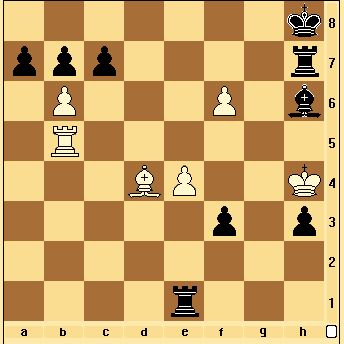
7k/ppp4r/1P3P1b/1R6/3BP2K/5p1p/8/4r3 w W wins.
For those who want to solve (there is at least Jeau-Marie!), some indications to save time by saving their Hercules arms:
1) On an insufficient first W-move, the B play Be3+ followed by Rg1+, Bxd4 and Rg1-g8 on a possible promotion.
2) On the 2nd move, the wK must go to the B-square, and one of the squares would hinder the B two moves later.
3) To prevent f8=Q, the sacrifice of the Rh7 to play Kh7 is insufficient. It is therefore necessary either to deflect the Bd4, or to remove it, or both.
4) After this 4-move manoeuvre constituting the introduction, the study proper can really begin.
Which pawn do you capture? You will know it only at the end, when you will have found the 8th W move.
Good research.
Finally, a reminder of a study by Kubbel (1938!) which proves if it were necessary that one can make simple and beautiful at the same time. Great art, that everyone can find and appreciate.
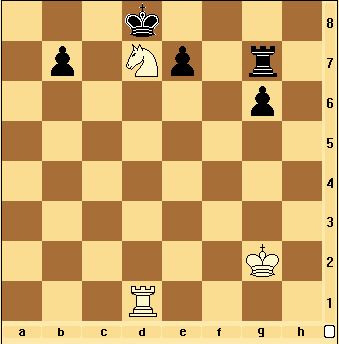
3k4/1p1Np1r1/6p1/8/8/8/6K1/3R4 w W win.
Don't forget a variation, it would be a shame.
And now the game of the day between Tatai and Karpov.
I know there are those who would summarise this game as "White goes for what doesn't belong to them and then capture it, that's why it's called an English opening" but that's completely politically incorrect and I'll refrain from relaying such comments.
1:Nf3 c5 2:c4 Nf6 3:Nc3 d5 4:cd Nd5 5:g3 g6 6:Bg2 Bg7 7:Qa4+
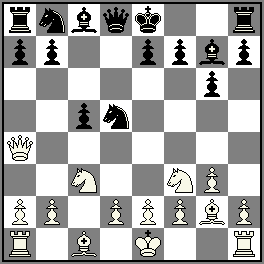
A sharp sequence already known at the time (1977) where the Ws win a P.
7:..Nc6 Better than 7:..Bd7 ?! 8:Qc4 Nb4 9:o-o
8:Ng5!
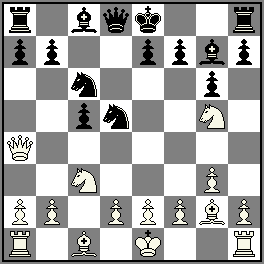
better than 8:Qc4 Nbd4 9:0-0 Qa5! 10:Ne4 Qa6!
8:.. e6 9:Nge4 Nb6! better than 9:..Qe7 10:Nxd5 ed 11:Nc3.
10:Qb5 c4 11:Na4 0-0 12:Nb6 ab 13:Qxc4
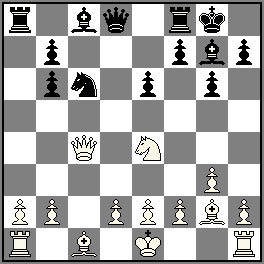
It is necessary to admit that this variation requires a very precise B play to keep a sufficient counterplay for P and that it was necessary to be very strong to find this continuation in which one is made in more destroy the structure of P on the D side to increase the activity.
Here, the audience, greatly reinforced by the arrival of friend Pierre, envisaged 13:...b5 14:Qb5 Nd4 15:Qd3 Bd7 16:e3? Bb5 17:Qb1 Nf3! 18:Bf3 Bd3! but W improves with 16:Nc3! and it is not certain that the B-play is sufficient. These reflections nevertheless allowed us to understand much better Karpov's comment that he had thought long and hard about the move 13:. Bd7 (indeed, this move takes up the previous ideas in a better way, but is not a world champion who wants) on which W has a unique move 14:Nc3 (fighting against the Bd7).
13:..e5 14:Qc2 Nd4 15:Qb1 f5 16:Nc3 e4 (Although not considered by Karpov, f4 was an interesting move)
17:d3 b5 (here, the audience found Larsen's suggestion 18:dxe b4 19:Nd5 then 19:..fxe suggested by Pierre very interesting, but I failed to note and participate in the analyses at the same time)
18:Be3 b4 19:Nd1 Rc8 20:de fe 21:Bd4 Qd4 (to understand a3, note the following 22:Qc2 Be6! 23:Qxe4 Bc4!) 22:a3 Bg4 (preventing 23:axb4 because of Qxb4+ 24:Kf1 Qd2) 23:Qc2
And there, the Master regretted, and I quote, "the absence of Rémy to find the next move". So I didn't calculate anything at all and announced a tempo 23:..Qd3,
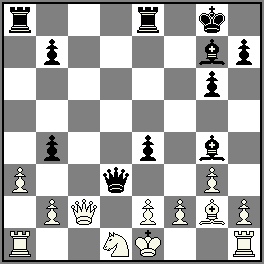
certain of the answer !
24:ed ed 25:Kd2 Re2+ 26:Kd3 Rd8 27:Kc4 Rc2+ (Note Antoni's variant which shows that things are still hanging by a thread : 27:Bd5!? Rd5 28:Kc4 Rc2 29:Kd5 Bf3 !) 28:Kb4 Rcd2! threatening to win the N 29:f3 Bf8+ 30:Ka5 Bd7
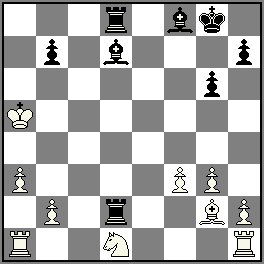
threatening Bc5 followed by mate. Resigns
Add a comment